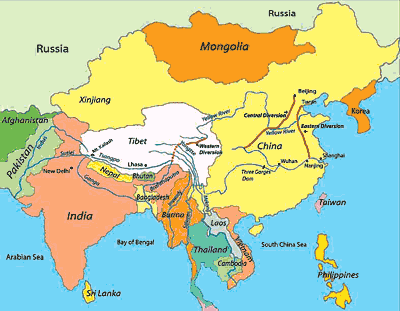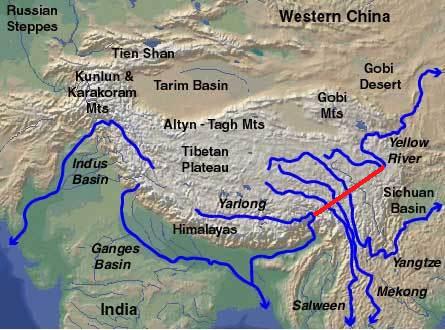இடாநகர் : ஆசியாவின் முக்கிய ஜீவநதியான பிரம்மபுத்ரா நதி, திடீரென்று வறண்ட சம்பவம் அருணாச்சல பிரதேசத்தில் பெரும்பரபரப்பை ஏற்படுத்தியுள்ளது. இந்த நிகழ்வை, அருணாச்சல் பிரதேச மாநில முதல்வரின் அரசியல் ஆலோசகரும், மாநில அரசின் செய்தித் தொடர்பாளருமான டாக்கோ தாபி உறுதி செய்துள்ளார். இது, சீனாவின் சதி வேலையாக இருக்கலாம் என்று கருதப்படுகிறது.பிரம்மபுத்ரா “வரலாறு” : திபெத்தின் தென்மேற்கு பகுதியில் யார்லங் ஷாங்போ என்ற பெயரில் உருவாகி, ஹிமாலய மலைத்தொடர் வழியாக உட்புகுந்து, இந்தியாவின் அருணாச்சல பிரதேச மாநிலத்தில் உட்புகுகையில், திஹாங் என்று பெயர் மாற்றம் பெற்று, தென்மேற்கு பகுதியாக பாய்ந்து அசாமில் புகுந்த புகுந்தவுடன் பிரம்மபுத்ரா என்று பெயர் பெற்று வங்கதேசத்தில் நுழைந்தவுடன் ஜமுனா என்று பெயர் பெறுகிறது (இந்தியாவின் யமுனை நதி அல்ல). கங்கை நதியின் டெல்டா பகுதிகளில் பாய்ந்து, அங்கு பத்மா நதியுடன் இணைகிறது. பின் மேக்னா என்று பெயர் பெற்று
இறுதியில் வங்காள விரிகுடாவில் கலக்கிறது.
சீனா தான் காரணம் : பிரம்மபுத்ரா நதி வரும்பாதைகளில், சீனாஏற்படுத்தியுள்ள செயற்கை தடுப்புகளினாலேயே, நதி வறண்ட சம்பவம் நடைபெற்றுள்ளதாக டாக்கோ தாபி கூறியுள்ளார். அவர் மேலும் கூறியதாவது, 2000ம் ஆண்டு ஜூன் மாதம் 9ம் தேதி, பிரம்மபுத்ரா நதியின் நீர்மட்டம் திடீரென்று 30 அடி அளவிற்கு அதிகரித்தது. இதன்காரணமாக, அருணாச்சலபிரதேச மாநிலத்தின் பெரும்பகுதி தண்ணீரில் சிக்கி தத்தளித்தது. திபெத்தில் இயங்கி வரும் நீர்மின் நிலையம் பலத்த சேதத்தை சந்தித்தது. இதில் சிக்கி பல பேர் பலியானதாக அவர் கூறினார். பிரம்மபுத்ரா.
நதி வறண்ட சம்பவம் குறித்து உயர்மட்ட விசாரணைக்கு உத்தரவிடப்பட்டுள்ளதாக அவர் மேலும் கூறினார்.
சிலநாட்களுக்கு முன், மத்திய பாதுகாப்புத்துறை அமைச்சர் ஏ கே அந்தோணி, அருணாச்சலபிரதேச மாநிலம் விஜயம் செய்வதாக இருந்தார். ஆனால், அதற்கு சீனா தரப்பில் எதிர்ப்பு தெரிவிக்கப்பட்டது நினைவிருக்கலாம். அருணாச்சல பிரதேச மாநிலம், இந்தியாவின் ஒருங்கிணைந்த பகுதி என்றும், இந்திய அமைச்சர் ஒருவர் , நாட்டின் மற்ற பகுதிகளுக்கு செல்ல மற்ற நாடுகளிடம் அனுமதி கேட்கத் தேவையில்லை என்றும், சீனாவின் இந்த கருத்துக்கு மத்திய வெளியுறவுத்துறை மற்றும் பாதுகாப்புத்துறை அமைச்சகங்கள் கடும் கண்டனம் தெரிவித்திருந்தது குறிப்பிடத்தக்கது.
Dam on Brahmaputra : Consequence and Reality Check
I have been reading about Chinese dams in Brahmaputra in Indian newspapers. As a typical lower riparian alarmist, most of the reports also add that China is planning to divert some of its water towards Eastern region, in addition to generation of 40,000 MW of electricity.
The Brahmaputra river follows an odd channel to flow to the sea. It flows towards east for almost half of its length in mountainous Tibet and then takes a U-turn (photo) to enter plains in Assam. Ultimately, it enters Bangladesh towards South and meets the Ganges before reaching the sea.
The place where it takes a U-turn, is known as Great Bend of Yarlung Tsangpo/Brahmaputra. At the same place, the river forms the deepest canyon of the world (Grand Canyon??). Only in 1998, a 30 mt waterfall was discovered nearby and since then China is planning to build a huge hydroelectric dam having an installed capacity of 40,000 MW.
The media reports also claim that there are proposals in China to divert some of rivers water too through the same dam to Eastern region. The author also claimed that China is planning to divert 40 BCM of water out of 71.5 BCM carried by Brahmaputra each year. One must remember that the water calculation is based on what it carries from Tibet to India. The same river has a runoff of an average of 550 BCM of water when it reaches Bangladesh. Where from this additional flow comes? There are two answers – the first is the Monsoon waters and the other is the water carried by the tributaries. The monsoon flow of Brahmaputra is almost 10 times that of its dry season flow (Source : Page 39-40, Rivers and Riverine Landscape in North East India By Sutapa Sengupta).
Now let us look at the possibilities. The first is only the hydro-power generation. This does not change anything for India. Hydro-power generation is non-consumptive usage of water and should end up increasing the dry season flow by 10-20% – which should be good for irrigation usage in Assam and Bangladesh. The success of this plan depends on how the irrigation planning is done. I am hopeful that China will also sell some of the electricity to India since it may be a cheaper option for them.
The next topic to discuss the feasibility of this project. There are basically three different ways to implement the project. The first is to build hydro-dam only. The second is to divert water only during monsoon. The third is to divert a constant volume of water throughout the year.
The first sounds feasible and I have already discussed it. The second should also cause no harm to India. It is understandable that during Monsoon, it’s the excess water that causes the problem as it floods vast area in India and Bangladesh. It’s good for China as well since it is diverting the water to an area that does not get rainwater at the same time of the year. It will get water for 3-6 months when India or Bangladesh does not need it.
The third one could potentially have dire consequences for both India and Bangladesh. It could be completed as the second phase of Chinese plan to interlink their rivers (this is how the first phase is). For India, the North-East is both food-surplus and water-surplus. After the diversion starts, the dry season flow could diminish by 20-30%. For a sandwiched Bangladesh, it’s time to share water with both Asian Giants – China and India. India is already taking 50% of Ganges water in the East. If Brahmaputra (Jamuna in Bangladesh) is compromised, it would virtually be a dry Bangladesh in lean season. A lot of alarmist authors also mentioned reduction in Hydro-power potential of North-East India due to Chinese diversion. I do not agree to them. First reason is most of planned hydro-power potential is actually in Brahmaputra tributaries. The lack in dry season flow would only block any “run-of-the-river” projects, but not anyone with a plan of reservoirs.
There are ways to cushion against the third problem as well. If Indians build reservoirs in Arunachal to hold the excess monsoon water, the condition should not be that bad. However, the loss of vast forest area and displacement of tribals from their land is regretted. The Indian Govt has already stepped a foot towards this (another post, news).
One thing to keep in mind that if India can not show any meaningful use of Brahmaputra waters, China has a right to divert them. This is why the first two plans has to be accepted by India even if it harms India. India does not “use” monsoon water, neither does it use the gradient of the Great Bend. The International law (though neither India nor China signed it) indicates the existing use as a parameter for equitable water sharing. China has already built a dam (photo) on Indus tributary. The first Chinese dam on Tsangpo is also coming up. So we don’t know what’s coming next.
Before signing off, I would like to do a reality check on how this plan would work. If a viewer can identify the river Brahmaputra (Yarlong on the map) on top of India, he can see the red marked channel (or the dotted red line on the map above) from the same river passing a string of rivers to reach the Yellow river. The rivers crossed includes Salween, Mekong and Yangtze – three of the largest in Asia. In the first phase, the plan is to build a connector between Yangtze and Yellow river as a part of Western routes.
It is logical to believe that China cannot divert water from Yarlong (Brahmaputra) before it does so from Salween and Mekong. [Adding later to clarify - because taking water from those rivers involves much less effort than what it takes to move Brahamaputra water]. So far, China has built three dams on Mekong, two are under construction and there are four more to come (map). However, there are no plans to divert Mekong water yet. Once it starts diversion of Mekong, a series of political conflict is expected – especially with ASEAN states – something that China could hardly afford. This could potentially delay the plan to add further water in the channel. Therefore, in my opinion, even if China diverts Brahmaputra, it won’t be soon. Literally, there is no such possibility in next 30 years in my opinion. By that time, energy-hungry India should “tame” the Brahmaputra and have sufficient control over it. If India fails to do that, it would be our problem because we would fail to meet our goal despite the mitigation plan is available. It’s better not to be the “Cry Baby” if we know the problem beforehand.
I can’t term the projected dire consequences of the diversion plan anything other than a mere Conspiracy theory at this point of time. The importance that Indian media attaching to it – proves that lower riparian alarmist nature is Universal. The last thing I want is a political conflict over water. India needs good relationship with China. Alarmist media should do a reality check before they push forward their agenda to inject fear in common Indians.
Source: http://horizonspeaks.wordpress.com/2009/06/28/dam-on-brahmaputra-consequence-and-reality-check/




